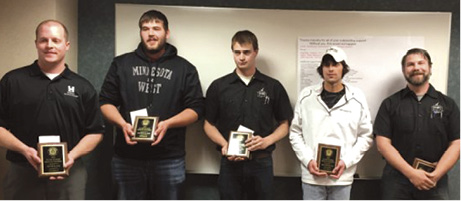Differences Between a Filter and a Strainer in a Hydraulic System

By Mark Ligon, Marketing Manager, Commercial Filtration Supply
Filters and strainers both remove contaminants. What is the difference, and which one should you use?
The team responsible for the hydraulic machine must determine the type of contamination control required, based on specific factors. Strainers and filters have similar functions, and it may not be clear which is truly needed. Exploring both options will help determine what would provide the most beneficial and cost effective solution.
To get the full picture, let’s look at how filters and strainers work. How are they similar? How are they different? What is required for proper contamination control in a hydraulic system?
Hydraulic systems are made up of many different working parts. They must be protected from contamination if they are to remain operational for years to come. If you don’t want to be constantly replacing large hydraulic systems, you should invest in a contamination control system consisting of strainers and filters. The right filters and strainers will keep the hydraulic system working at its best.
Similarities and differences
 Filters and strainers were designed to do essentially the same task but in slightly different ways, and the similarities can be confusing. Both are responsible for removing suspended particles in gasses or liquids, protecting the downstream equipment from damage. They are sometimes found in what is called a duplex system, in which one set can be cleaned while the other is in operation. However, they are not interchangeable.
Filters and strainers were designed to do essentially the same task but in slightly different ways, and the similarities can be confusing. Both are responsible for removing suspended particles in gasses or liquids, protecting the downstream equipment from damage. They are sometimes found in what is called a duplex system, in which one set can be cleaned while the other is in operation. However, they are not interchangeable.
The purpose of a strainer is to prevent larger particles from traveling into the hydraulic system. These large particles would cause severe damage and produce even more particles that would contaminate the entire system.
Strainers come in shapes and sizes that are meant to fit in a variety of applications. They can usually be removed and cleaned.
Filters remove smaller particles than strainers. They catch contamination in a gas or liquid, providing clean fluid downstream. Strainers may capture contaminants as small as a grain of sand. Filters may capture contaminants smaller than a red blood cell. Some filters are reusable, but most require periodic changing.
A common rule is that filters remove particles smaller than 40 microns, a particle size nearly impossible for the naked eye to see. Strainers deal with particles larger than 40 microns, which are visible when inspecting the fluid. Hydraulic systems require both flow and pressure to do work. Both strainers and filters are in the fluid stream and will cause a loss of pressure that will increase as they become saturated with contaminants. Filters and strainers must be properly sized to minimize the pressure loss.
Types of strainers and filters
Several types of strainers and filters can work in a hydraulic system. The most common characteristics to consider when making a choice include:
- Types of fluids
- Operating pressures
- Operating temperatures
- Maximum fluid flow
- Pressure loss through filter
- Filtration efficiency requirements
- Type and volume of the contaminants (estimation)
Let’s look at the most common strainer and filter components within a system.
Inlet strainer.This strainer is most commonly found in the hydraulic reservoir, and its sole purpose is to keep insects, nuts, bolts, and other particles at least 150 microns or larger out of the pump.
Low-pressure/inlet filters. These spin-on filters are most often used between the reservoir and the pump. They are designed to protect the pump from smaller particles that are in the fluid.
High-pressure filters. The purpose of this cartridge-style filter is to clean the fluid as it moves downstream of the pump, protecting the expensive parts of the system and helping avoid catastrophic machinery failure.
Reservoir breather filters. These filters remove contamination from the air entering the hydraulic reservoir. Other notable characteristics include bag filtration, cartridge filtration, pipe strainers, and simplex and duplex filtration systems.
The importance of filters and strainers
The high operating pressures and speeds of modern hydraulic systems make them more susceptible to damage from particulates. Damage could include:
- Internal leaking of the hydraulic system, which can result in decreased system performance
- Particles accumulating at key areas of the system, resulting in sticking, stalling, and component failure
When considering which filter or strainer mesh size to select, the amount of contaminant you expect matters. A rule of thumb is to choose mesh sizing that is slightly smaller than the anticipated contaminant size. Keep in mind that the finer the strainer or filter, the more often it needs to be cleaned or changed. The contamination control system should be arranged to minimize downtime when servicing the filters or strainers so as to not interrupt production. Here duplex housing plays a part. Duplex housing allows one set to continue working while the other is serviced. Without duplex housing, you must shut down and depressurize the entire system for maintenance.
Flow rate matters
In addition to considering the size of the contaminants, the flow rate also comes into play when choosing strainers and filters. Strainers may have a lower pressure loss for a given flow but may allow damaging particles to pass into the system. Filters may have a higher pressure loss for a given flow but are better at keeping harmful contaminants from traveling downstream.
The easiest way to mess up a hydraulic system and cause costly damage is to allow large particles to ping-pong their way through the system. A contamination control system with strainers and filters reduces the occurrence of these particles. A smooth-running system with duplex or simplex filtration helps the hydraulic equipment last longer, reduces unscheduled maintenance, and increases productivity.
Mark Ligon is marketing manager for Commercial Filtration Supply, a supplier of industrial filtration products, including self-cleaning strainers, bag filtration, cartridge filtration, and replacement parts. For more information, visit: www.commercialfiltrationsupply.com








Information is very valuable. Mostly people don’t know all this. Thank you for detailed information.